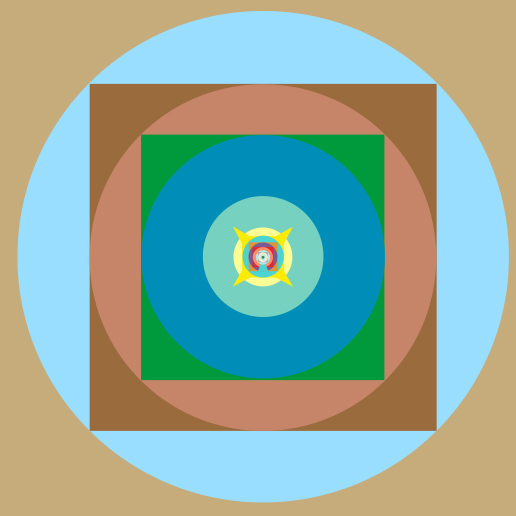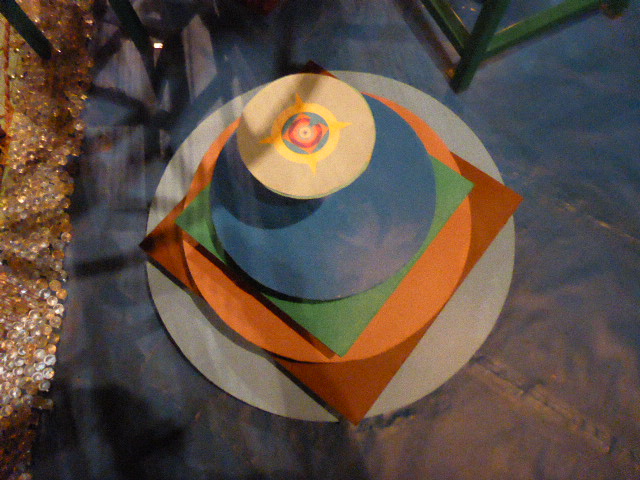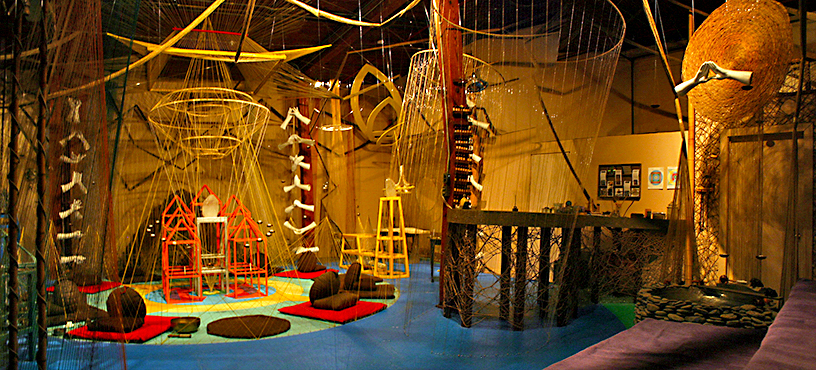~ The Story Of The Lost Expedition (part four) ~ |
| xxxx |
1) Gifts From The Elders - During our recent stay in the Orphanage the Elders have left four different things for us to play within. Each was an opportunity for us to remember more about The Lost Expedition as each new level of The Story arose. |
|
||
A Clearing In Maya Woods This was a wild and intimate place in the primal forest where many strange beings interacted with all those who ventured in. |
||
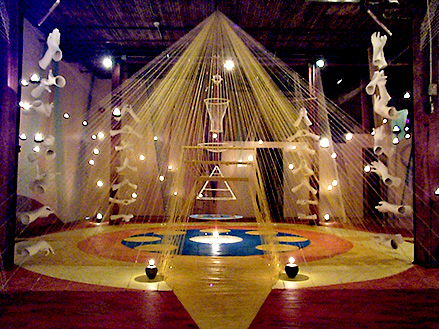 |
Garian’s Mandala This mandala was located inside a pyramid and had a lot to do with chakra energies and the various ways that these energies could be rearranged and focused. |
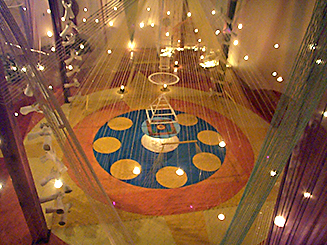 |
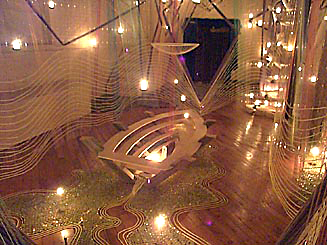 |
The Mystic Box Of Ho On the outside was a sailing ship that sailed the sea of our memories.On the inside was a quiet place where we sat and remember what those memories were. |
|
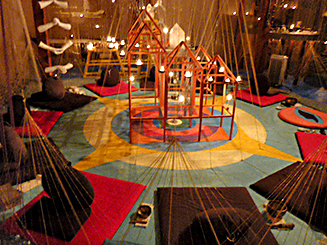 |
The Mahamundi Mandala This mandala contains much information about where The Lost Expedition met and what their work with other circles of sentient beings entailed |
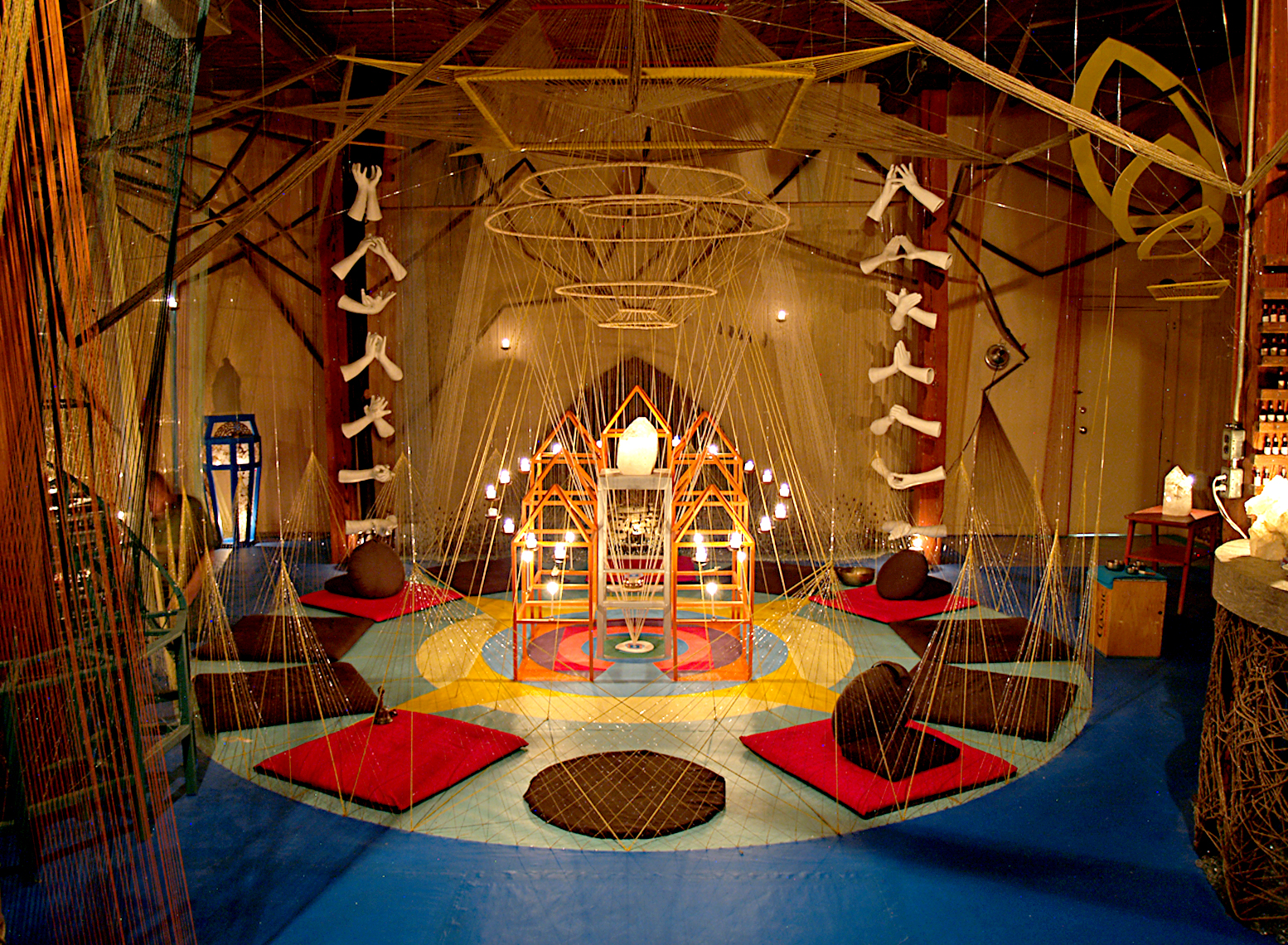 |
- The most recent thing that the Elders have left for the orphans to play with is the Mahamundi Mandala. As it turned out this was the most compelling gift from the Elders so far. It contained a great deal of information (particularly about The Lost Expedition and its circle of seats) that had been deeply forgotten. |
|
2) The Mahamundi Mandala (part one) - The Mahamundi Mandala shows the relationship between landscape and consciousness - The mandala is not from an objective point of view, but rather from a subjective, human point of view. It is specifically for humans; it shows how a human can move from one state of consciousness to another and how the Open Circle relates to other circles of sentient beings. The basic geometric language of the mandala includes: |
| xxxx |
Circles = states of consciousness Squares=landscapes where consciousness manifests. Landscapes are places where we can reside with a certain level of consciousness, where a certain level of consciousness is indigenous. Moving from a square to an inscribed circle = becoming conscious in a landscape Moving from a circle to an inscribed square = a new consciousness level gives access to a new landscape where we can now reside, where our new state of consciousness is indigenous. |
~~~~~~~~~~~~~~~~~~~~~~~~~~~~~~~~~~~~~~~~~~~~~~~~~~~~~~~ |
Let's take a look at the Mahamundi Mandala and see what the various circles and squares signify and how they interrelate: |
- the light blue circle = primal consciousness - From where does this original consciousness arise? There is nothing outside it, it is not generated by any shape, it’s just there. There’s a great deal to say (or not say) about this, so let’s let it go for now.
|
- the dark brown square = the landscape of the everyday world - The landscape of the place we inhabit and call our own: a solid unchangeable fact. But actually it’s not as substantial as we’d like to believe. It’s only the way we’ve all agreed to perceive the world. It’s a map of what we think the world is (but is it really the world itself?).
|
- the light brown circle = consciousness in the everyday world - This consciousness state equates with meditation, waking up in the spiritual sense, visionary states arising when some other landscape is seen and contacted, artistic vision or state of artistic expression. |
- The light brown circle doesn’t block off the brown square; you don’t lose touch with the everyday world. It’s an added perception that lifts you slightly above the landscape of the everyday world.
|
- the green square = the Territory - a more sentient landscape than the everyday world, the landscape where the light brown state of consciousness is indigenous - The everyday world is a place where mostly form is perceived (with little or no emptiness in evidence); the Territory displays form and emptiness in a more intimate mixture. It’s the landscape where creative expression is an on-going indigenous quality of action. |
- The green square doesn’t block off the brown square. When you are in the Territory you are also in the everyday world at the same time. It is an additive quality. You are more conscious here and you can interact with both landscapes simultaneously. |
- Moving from the everyday world to the Territory is not all that easy to do. - There are some points in the everyday world square that do not give easy access to the Territory square. If you look at the corner sections of the everyday world square you will see they seem isolated from the border to the Territory. If you were located in one of these corner sections there is only one single point where you could change landscapes and move into the Territory square (without first changing your state of consciousness): at the tip of the right angle that makes the corner of the Territory square. |
- This would be quite unlikely because you’d have to stumble upon that one point of contact with the border to the Territory and then blindly take a giant leap up to the next available landscape. So by looking at the relationship between the Territory square and the everyday world square we can generate some useful tactics in the everyday world: stay out of corners! They may seem safe and defendable, but there’s no place to go. |
- The centre of the everyday world square isn’t such a good place to be either. There are no available borders to cross going into the Territory. If you do manage to hit the border of the Territory square (without changing your state of consciousness first), you’d be crossing the wrong way, back to the everyday world again and not into the Territory square. |
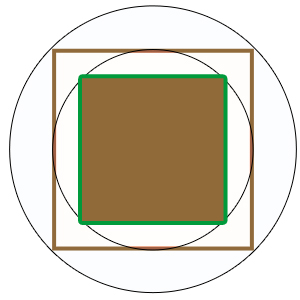 |
| xxxx |
- This inside position in the everyday world square corresponds to being successful in the everyday world but feeling unconnected to a more meaningful source. Curious isn’t it? We’re often urged to move to the centre of the everyday world where we’ll be more successful and free. But the mandala gives us the opposite advice: Stay out of the centre! It may seem like you can attain something there and be able to do whatever you want, but there’s nothing to do there except what you’ve already done - and no place else to go. |
- But if you can find your way into one of the wedge shaped places you have some hope. The border of the Territory square is now very accessible if you are able to shift your state of consciousness and see it. Seeing the border is not as difficult as seeing the Territory; the border presents itself continually if you approach it in the right way. |
- The position of the wedges are along the outside portions of the everyday world, but centered there. This position in the everyday world square is unsettling but productive. - The advice that is generated here: move towards the outside edges of the everyday world and centre yourself, shift your consciousness and pay attention. When the sight of the Territory presents itself: move to the border, lift yourself up and enter: there’s somewhere to go. |
~~~~~~~~~~~~~~~~~~~~~~~~~~~~~~~~~~~~~~~~~~~~~~~~~~~~~~~ |
- Let’s jump back outwards to look at how the everyday-world square is inscribed within the original light blue consciousness circle. Now we didn’t really want to say all that much about this circle before; and we certainly don’t want to say too much more now (but at least let’s try to say something). |
- First thing to notice: there’s a lot of this circle’s area that does not lie in the everyday world. Even shifting your consciousness and going on into the Territory, you still don’t have access to the wedge-like parts of the light blue circle that lie outside the brown everyday world square, or any other portion of the primal consciousness that seemingly lies underneath it. |
- Now it’s true that this original light blue consciousness circle is not separate from any of the inward forms; it interpenetrates the everyday world, it intermingles its substance with the Territory as well. In the everyday world we aren’t able to notice this (even if we believe it must be so). In the Territory we’re still not able to see the original light blue consciousness circle (though we’ve shifted enough to play with some of it’s energy). - But still, even so, the original light blue consciousness circle is seemingly inaccessible from any other state of consciousness that we might attain. So how do we begin to know what lies outside the everyday world and gives rise to the everyday world itself through it’s consciousness? |
- Actually we’re really quite familiar with how to get there in a non-conscious way. Death! Rebirth! Reincarnation is simply moving back and forth between this circle and the everyday world square. Karma involves the vector of that passage. If you move from the everyday world to the original consciousness circle in just this direction with just this speed (life actions) you will bounce off the inside edge of the circle and return to the everyday world square in a certain specific way (rebirth conditions). |
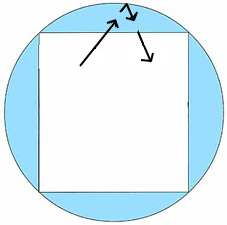 |
- But since we don’t want to die just yet, let’s go on inwards within the mandala to look for some other access to the original light blue consciousness circle. Let’s return to the Territory and continue on in from there. |
~~~~~~~~~~~~~~~~~~~~~~~~~~~~~~~~~~~~~~~~~~~~~~~~~~~~~~~ |
- the dark blue circle = consciousness in the Territory - Being conscious in the Territory is hard to describe specifically, particularly so because it is individually specific for each individual who experiences it. In a general way one could say it’s an intensely more intimate relationship with both the everyday world and the Territory. And it lets us lift ourselves up just a bit above both of these landscapes to look further ahead to the next shift we are hoping to achieve. |
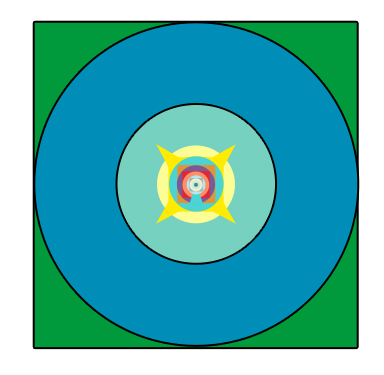 |
- So. Consciousness in the Territory leads to...... to what? Not another landscape because there is no square inscribed inside for it to manifest in. - The next inward shape is another circle, another state of consciousness. But how do we get there if there isn’t any landscape square for our shifted consciousness to reside within? How do we cross this gap between the dark blue circle and the aqua circle without a landscape square to support us? - This new shift of consciousness (from one circle to another circle) is of a different type than what we’ve encountered before (from a circle to a square or from a square to a circle) |
- Perhaps it would be useful for us to examine the missing shapes in the gap; they may not be all that available to us, but they are definitely imbedded in the structure of the mandala.. What do they signify? - The two missing squares in the gap are the two landscapes that the members of The Empty Circle inhabit, and the two missing circles are the two states of consciousness that are indigenous to those two missing landscapes. (!) |
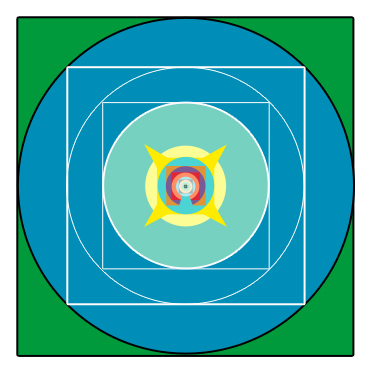 |
- The gap that is encountered here at this location in the mandala carries a number of implications which are important for us to consider. - This gap indicates that there are only two possible landscapes for us (as humans) to access and inhabit, at least at this level of our evolution. - It suggests that two landscapes (with two attendant consciousness states) could well be the norm for any other sentient beings, human or otherwise. - It also suggests that different sentient beings can assist each other in accessing and inhabiting other states of consciousness not “naturally” available to one or both of them by establishing a relationship with each other and working together to bridge the gap normally filled by a landscape and the consciousness states indigenous there. - The sentient story presented by the mandala is telling us thatwe, as returning members of the Lost Expedition, are being helped by The Empty Circle to change our level of consciousness to the degree necessary to move across this gap between the two levels of consciousness and arrive at the Circle Of Seats. - The mandala is also showing us that the circle of seats where the Lost Expedition met is not located in the everyday world, nor can it be found in the Territory either. The state of conscious that is necessary to access the circle of seats is one that is usually only indigenous to The Empty Circle (though we can find our way there with their help). |
~~~~~~~~~~~~~~~~~~~~~~~~~~~~~~~~~~~~~~~~~~~~~~~~~~~~~~~ |
3) The 3D / 6D Mandala |
|
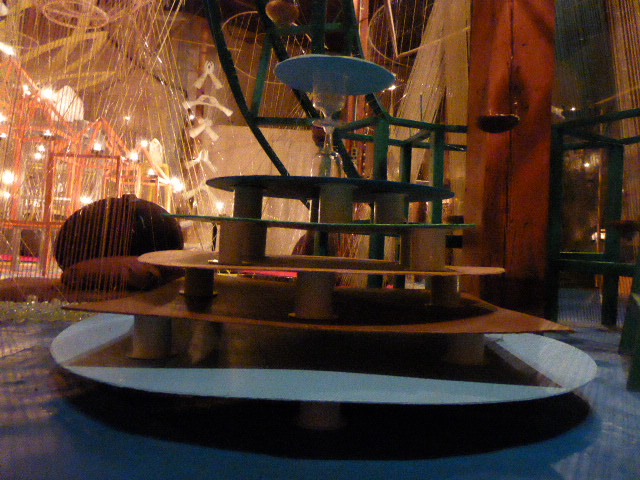 |
- Mandalas are often 2D representations of a 3D construction (like the floorplan of a building). - The Mahamundi Mandala as presented in the Orphanage is a 3D mandala which also includes a 2D representation painted on the floor of that 3D construction. - There may be more to this dual representation than initially meets the eye. - Humans need a landscape to manifest and experience different states of consciousness. A landscape needs three dimensions for a human to be able to act and interact within it. Or to put it another way: we can think in 2D but we act in 3. From the human actional point of view dimensions come in sets of three. We need three dimensions to actualize their implied states of consciousness. |
- In the well known book Flatland (1884) the author (Edwin Abbott Abbott) investigated how a 2D resident of Flatland would experience our 3D everyday world. - For instance: a 3D sphere passing into and through the 2D Flatland world would first appear to a resident of the Flatland landscape as a point, then as a circle that got larger and larger in circumference, then as a smaller and smaller circle until it disappeared. |
- In the Mahamundi Mandala the two humanly accessible landscapes (the everyday world and the Territory) are both presented two dimensionally as squares (dark brown and green).The consciousness states that are accessible to us are presented two dimensionally as circles (light brown and dark blue) Kind of a little like Flatland in a way. But hold on - there’s an additional 3D space above and beyond the everyday world and the Territory depicted below on the floor. So... in the sense that Flatland presents the relationship between 2D and 3D, the mandala presents the relationship between 3D (depicted as a flat plane on the floor) and 6D (the humanly necessary next set of three dimensions. (!) |
- To get a better sense of all this it helps to change your sense of scale and take it all in with a few smaller steps instead of in one large leap. - Try thinking of it this way: act as if you believe all the three dimensional characteristics of the everyday world landscape are still all there intact on the floor. Except that the “3D-ness”, the up-and-down-ness it includes, is very small, substantially small, so very very incredibly small that it’s hard to see any height at all. Then as you rise just a little bit above the everyday world to the light brown consciousness circle, you’re not high enough off the 3D plane yet to really see very much outside where you are now, but you sense that there might be something more than you thought was there before. As you rise a bit higher to access the green Territory square the feeling of this new spaciousness grows. If you rise even higher and access the blue consciousness circle you may even catch a glimpse or two of the vast new space above and beyond where you think you are now. |
|
- So this mandala that is in the Orphanage is actually a 6D representation (which includes a 3D component that underlies it). It shows the relationship between a six dimensional space (which humans are usually not able to see or interact with) and the humanly accessible three dimensional spaces (the everyday world and the Territory) we can naturally inhabit.
|
- Initially you may find it hard to act as if you believe you can be in this 6D space; but if you persist at least you will see why you and me (and everyone else) can’t see or interact with whatever is there in the 6D landscape from a 3D point of view. We might sense the shadows of their 6D shape that fall on our 3D landscape below. But if we don’t rise above our native 3D landscape we can never know what casts the shadows we feel intuitively from time to time, especially so when a 6D shape brushes the surface of our 3D home. |
| xxxx |
~~~ End Of Part Four ~~~ |
| xxxx |
~~~~~~~~~~~~~~~~~~~~~~~~~~~~~~~~~~~~~~~~~~~~~~~~~~~~~~~ |
| xxxx |
~~~ Continue on to Part Five ~~~ |
~~~ Go back to Part Three ~~~ |
~~~ Return to main story link page ~~~ |
